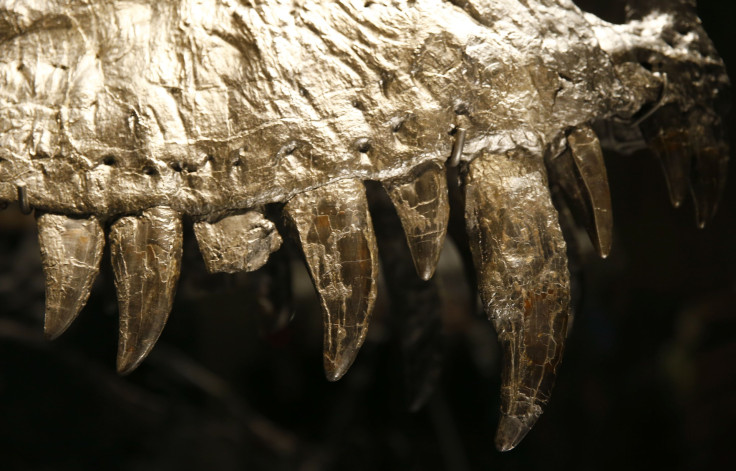T. Rex Bite Could Crush 8,000 Pounds, Allowing The Tyrannosaurus To Consume Bones Of Other Dinosaurs

The very name of Tyrannosaurus rex conjures up images of a large, hulking monster with massive snapping jaws, capable of tearing into not just the flesh but even the bones of its prey. And while we now know its arms were disproportionately small, given its large body, the formidable power of its teeth is indisputable.
Researchers from Florida and Oklahoma state universities investigated the teeth and bite mechanism of the T. rex to understand how the dinosaur, which stood about 15 to 20 feet tall and measured 40 feet from head to tail, exerted 8,000 pounds of force with its bite. To put that into context, its bite could crush three small-sized cars. That is over twice the strength of a crocodile’s bite, who are currently the animals with the most devastating bite.
Read: A New T. rex Fossil Found In Montana
In a study published Wednesday in the journal Scientific Reports, the researchers found a T. rex’s long, conical teeth generated 431,000 pounds of pressure per square inch, allowing it to feed on not just the flesh of other dinosaurs but also crush the bones of its prey and consume the nutrients inside.
“It was this bone-crunching acumen that helped T. rex to more fully exploit the carcasses of large horned-dinosaurs and duck-billed hadrosaurids whose bones, rich in mineral salts and marrow, were unavailable to smaller, less equipped carnivorous dinosaurs,” Paul Gignac, assistant professor of Anatomy and Vertebrate Paleontology at Oklahoma State University Center for Health Sciences, said in a statement.
For the study, the researchers first looked at how the musculature of crocodilians — close relatives of dinosaurs that include crocodiles, alligators, caimans, gharial and false gharial — aided their bite force, and then compared that with how it works for birds, which are the only living dinosaurs. Using the data, they generated a model for T. rex.
“Having high bite force doesn’t necessarily mean an animal can puncture hide or pulverize bone, tooth pressure is the biomechanically more relevant parameter. It is like assuming a 600 horsepower engine guarantees speed. In a Ferrari, sure, but not for a dump truck,” Florida State University professor of biological science Gregory Erickson said in the statement.
Read: Some Dinosaurs Were Gentle Lovers Who Indulged In Foreplay
The capacity to crush bones — called extreme osteophagy — is usually seen in large carnivorous mammals, such as hyenas and wolves in the present day, but is completely absent in reptiles, who don’t have occluding teeth. T. rex, a prehistoric reptile, is likely unique among that class of animals in having developed the ability without having specialized, inter-locking teeth that are seen in mammals.
The new open-access study, titled “The Biomechanics Behind Extreme Osteophagy in Tyrannosaurus rex,” also goes to show the sophisticated feeding abilities of predators like hyenas and gray wolves first appeared in reptiles in the time of dinosaurs.
© Copyright IBTimes 2024. All rights reserved.





















